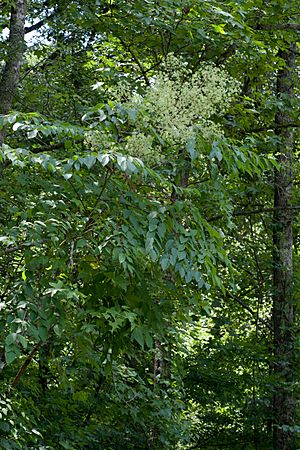Devil's walking stick facts for kids
Quick facts for kids Devil's walking stick |
|
|---|---|
 |
|
| Conservation status | |
| Scientific classification | |
| Genus: |
Aralia
|
| Species: |
spinosa
|
 |
|
| Natural range of Aralia spinosa | |
The Devil's Walking Stick (scientific name: Aralia spinosa) is a cool plant found in eastern North America. It gets its name because its stems, leaf stalks, and even the middle parts of its leaves are covered in really sharp spines! People also call it the Angelica-tree.
Sometimes, this plant is called Hercules' Club or Prickly Ash. But be careful! There's another plant with a similar name, Zanthoxylum clava-herculis, which is sometimes called the "toothache tree" because it was used to help with toothaches. The Devil's Walking Stick does not have these same special properties.
People sometimes grow the Devil's Walking Stick because it looks very unique, almost like a tropical plant. It has big, lacy leaves that make it stand out. It's related to an Asian plant called Aralia elata, which is also grown in gardens.
Contents
What Does It Look Like?
The Devil's Walking Stick is a deciduous plant, meaning it loses its leaves in the fall. It can be a shrub or a small tree, growing from about 6 to 26 feet (2 to 8 meters) tall. Its trunk can be up to 6 to 8 inches (15 to 20 cm) wide.
The young stems are thick and covered with sharp spines. The plant often grows in groups of straight trunks, almost like an umbrella.
Leaves
The leaves of the Devil's Walking Stick are huge! They are some of the biggest leaves of any temperate tree in the United States. They can be about 3 feet (1 meter) long and 2 feet (60 cm) wide. Each big leaf is made up of many smaller leaflets, which are about 2 to 3 inches (5 to 8 cm) long. The stalks of the leaves are also prickly.
In the fall, these large leaves turn a beautiful bronze-red color with touches of yellow. This makes the tree look very striking and pretty.
Flowers and Fruit
In late summer, the plant produces many small, creamy-white flowers. These tiny flowers (about 0.2 inches or 5 mm across) grow in very large clusters called panicles, which can be 1 to 2 feet (30 to 60 cm) long.
After the flowers, the plant grows purplish-black berries. These berries are about 0.2 to 0.3 inches (6 to 8 mm) wide and ripen in the fall.
Trunk and Bark
The bark of the Devil's Walking Stick is light brown. It has rounded, broken ridges. The branches are thick and covered with strong, straight or curved prickles. You can also see narrow marks on the branches where old leaves used to be.
Wood
The wood of this plant is light brown with yellow lines. It's light, soft, and breaks easily.
Where Does It Grow?
The Devil's Walking Stick grows all over the eastern United States. You can find it from New York down to Florida along the coast, and as far west as Ohio, Illinois, and Texas. It likes to grow in deep, moist soil.
These plants often grow in the understory of forests (the plants growing under the main trees) or at the edges of forests. They can form thick groups by sending out new shoots from their roots.
Special Meaning to Native Americans
The Iroquois people really admired this tree because it was useful and not very common. They would plant young Devil's Walking Stick trees near their villages and on islands. This helped protect the valuable fruit from animals. The fruit was used in many of their foods. Iroquois women would even put the flowers in their hair because they had a nice lemony smell. The flowers could also be traded for money.
Confusing Look-Alikes
For a long time, people thought that any Devil's Walking Stick plants found north of Maryland and Delaware had been brought there by humans. However, we now know that some of these plants are actually Aralia elata, which is the Japanese Angelica-tree. This Asian plant is an invasive species, meaning it can spread quickly and harm local plants.
It can be hard to tell A. spinosa and A. elata apart in nature. In some places, like Philadelphia, the Japanese Angelica-tree is taking over from the native Devil's Walking Stick. Scientists are still studying what impact this might have on the environment.
Uses of the Plant
The young leaves of the Devil's Walking Stick can be eaten! You need to gather them before the prickles get hard. Then, you chop them up finely and cook them like a green vegetable.
People started growing the Devil's Walking Stick in gardens back in 1688. It's still popular today because of its interesting leaves, prickly stems, big flower clusters, and pretty fall colors. These plants grow slowly but are tough and can do well in city areas. You can grow new plants from seeds or by taking cuttings from the roots.
Early American settlers believed this plant could help cure toothaches.
In a scientific study, extracts from the plant were tested. During the American Civil War, this plant was used as a medicine. The study showed that these extracts could fight against bacteria that cause wound infections, even bacteria that are hard to treat with other medicines.



